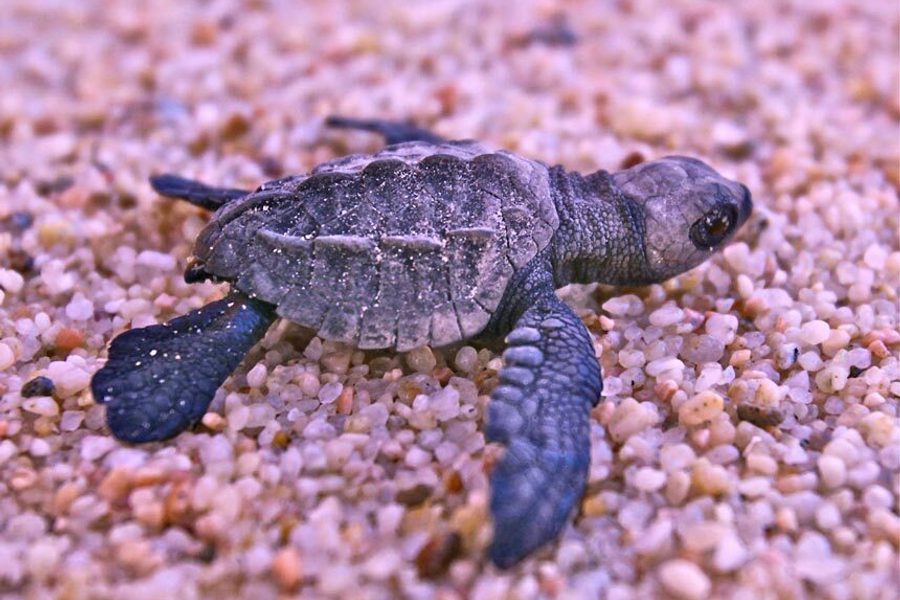
Glistening black under the light of the full moon, they scuttle toward the water in a rapid-fire herd, just as their forebears have done for millennia before them.
Each Olive ridley turtle hatchling is two inches long and weighs less than an ounce. But each shows outsized exuberance as it barrels toward the challenges ahead: a plunge into the surf, a scrabble against the tide, and a journey that can take the turtles, over the course of their five-decade lifespans, from this Mexican beach to Asia and back again several dozen times.
Their chances of surviving to adulthood are one in 1,000. Watching from the waterline at 2 a.m., clutching my empty turtle-hatchling basket in one sunburned hand, I feel my heart leap to my throat, and hear my friend Kuba Gogolewski heave a hopeful sigh.
Here on the Pacific coast of Mexico, where we are volunteering for a turtle-rescue organization, Kuba and I have seen firsthand evidence of the human meddling that creates desperate odds for sea turtles. We have stumbled on footprints left by poachers who sneak onto beaches and steal turtle eggs, considered aphrodisiacs in Mexico. We have seen the glare of hotels and condos along the beach, toward which baby turtles, programmed by evolution to gallop toward the moonlight on the sea, now run in the wrong direction. And as we meander along the shoreline on our late-night rounds, we have picked up countless baggies that sea turtles can mistake for food, with fatal results.
Alarmed by how human meddling threatens the turtles, I pray the just-released hatchlings will make it. Can they survive the damage done by humans?
A lightning-white sand crab scuttles over my feet, snapping me out of my reverie. Kuba breaks into a brash whistle (to the tune of the mountaineering songs he has learned in his native Poland, and loud enough to warn nearby poachers that this beach is being patrolled).From the distance comes the roar of a battered dune buggy charging up the coastline a mile away. At the wheel is Frank Smith, founder of our turtle-rescue group, Grupo Ecológico de la Costa Verde.
Smith, a former California forest ranger, retired to San Pancho, Mexico, in 1990 — and was shocked to discover that its beaches’ legendary turtles were no longer crowding the dunes during their April-to-December egg-laying season. What had happened? Locals told Smith that poachers could now earn up to 10 days’ pay for a single nest of eggs. They pointed to the new resorts and to the garbage littering the sand. Smith decided that instead of retiring, he would become a shoestring-budget turtle rescuer. He racked up phone calls, fired out emails, launched a website and rounded up an eager band of international volunteers.
Smith reasoned that when it came to Olive ridleys, acting locally could have a profound impact. When these turtles lay their eggs, they return to the same beaches where they themselves hatched. By saving nests and hatchlings, Smith believed he could eventually restore the abundant turtle population of his adopted town.
Of course, this was just one stretch of beach in just one of the 80 countries where Olive ridleys can be found. “Still, I knew it could make a difference,” says Smith. He knew Olive ridleys here were under particular threat — only on the Pacific coast of Mexico is the species classified as endangered by the U.S. National Oceanic and Atmospheric Administration. So Smith taught volunteers how to monitor mother turtles during egg laying, how to bring turtle eggs to man-made nurseries for incubation, and how to release newly hatched turtles to the safety of the sea.
Turtle trance
As the sputter of the dune buggy fades into the star-pierced night, Kuba and I wander up the beach looking for poachers and baggies. We also search for mother turtles, and soon enough, we find one struggling to get ashore. She is caught on a lip of sand, her flippers pawing at the air, her shell (olive green, versus a hatchling’s grey) heaving as she strains. We rush to help, and a few grunts later, push the 80-pound turtle onto land. Resting now on a level patch of sand, the mother turtle lowers the back of her barnacled shell into the nesting position. Scooping her flippers in a circular motion, she digs out a six-inch-wide channel. With her neck extended and her eyes fixed (a stare I come to know as the “turtle trance”), she deposits her clutch of 100 eggs one by one. Twenty minutes later, she circles twice and pats down her nest to disguise it from predators.
The mother turtle holds my gaze for a moment. Then she lurches back toward the waves until the ocean laps over her, and her movements, awkward on land, become a graceful ballet in the sea.
When she is gone, Kuba and I gently scoop the sand out of her nest and ease her white, billiard-ball-sized eggs into plastic bags. We mark the nesting site with an X, and place a stick there to help Smith chart where the nest is located.‘
After learning a few new mountaineering tunes (and catching a scattershot, 6 a.m.-to-noon sleep), I spend the next shift monitoring the nursery in Smith’s crabgrass-and-cactus-strewn yard. The eggs that Kuba and I have collected, along with 350 other nests, are resting in the nursery in sand-filled Styrofoam coolers. Each nest is in a different stage of its two-month incubation, and each is kept (thanks to fans and tarpaulins) below 89 degrees Fahrenheit to ensure the hatchlings’ survival. Here are the eggs we just harvested, labeled with today’s date. And here is a nest of just-hatched baby turtles. Stretching their limbs as if warming up for that night’s gallop to the sea, they blink the sand from their wizened faces. When I pull on latex gloves and cup them in my hands, they stare through me as if they can probe my innermost thoughts.
Out to sea
That was in 2008. I’ve thought about the sea turtles’ brazen stare — and about how looking into their eyes felt like looking back through time — quite often since.
Smith’s success inspires me. Since starting his nonprofit in the 1990s, he has seen a sixfold increase in the number of Olive ridleys laying eggs in San Pancho. This year, he and his team discovered more than 1,400 nests and placed nearly all of them safely in nurseries.
The Olive ridleys, for their part, stoke my sympathy. The most abundant turtle species on earth, they are plenteous, as are we. They’ve worn the test of time, just as humans have (though they predate us by 245 million years). They’re now under threat. And so are we. Experts say we will soon exceed the maximum amount of global warming that our planet can sustain before catastrophe strikes. Researchers predict that by 2050, there will be 9 billion humans on earth, necessitating that we double our current food supply. Can we, despite the grim odds, hope to survive our own meddling?








